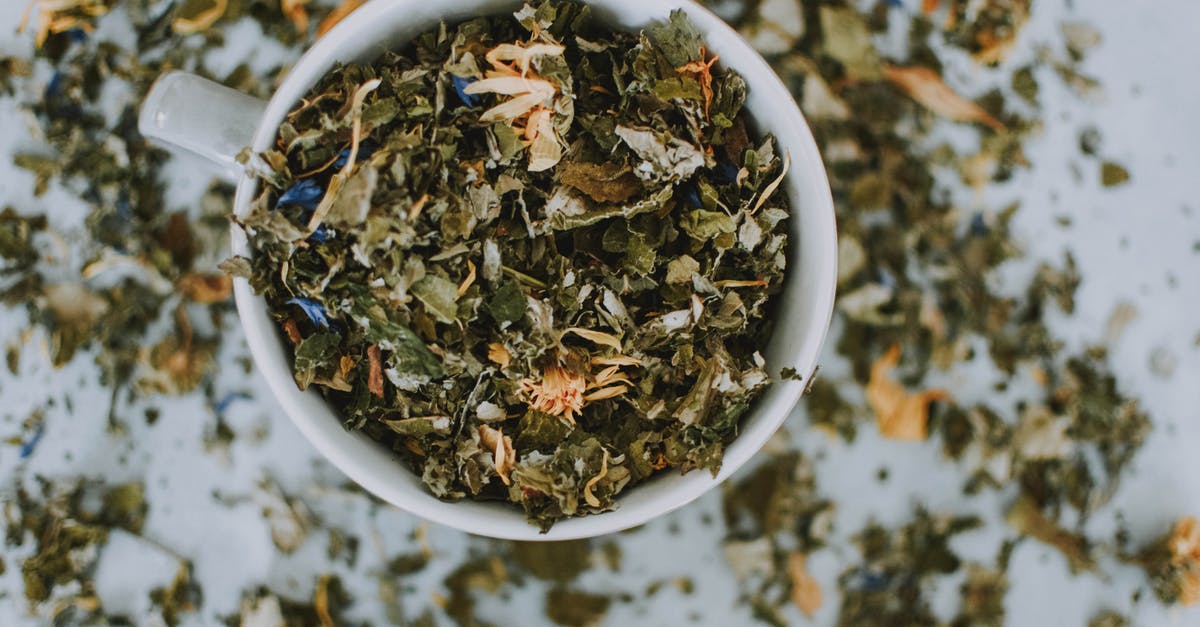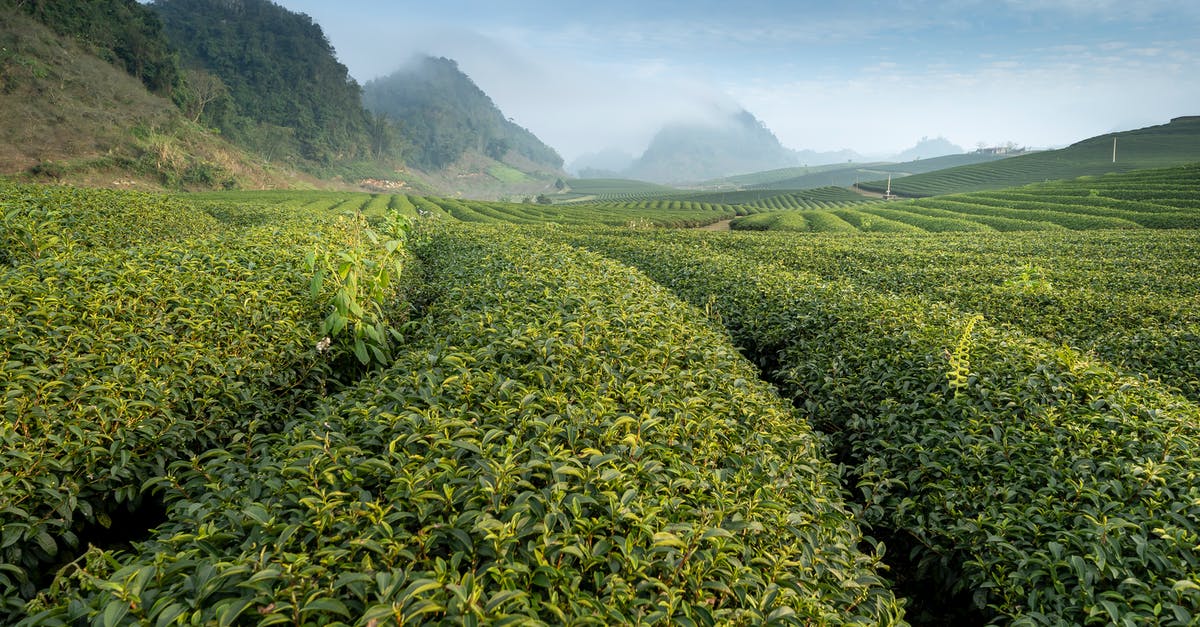Why is my green tea brown?

As Crystal Gale once wrote, "You're gonna make my green tea, brown." Or something like that.
When I typically order (the free or close-to-free) green tea at Japanese restaurants, it's usually noticeably green. At home, regardless of brand and time on the shelf, it's typically brownish. I follow good guidelines for making green tea: 170 degrees for about 90 seconds.
Am I buying the wrong kind of tea; or are restaurants using food coloring?
UPDATE: I'm pretty sure the Japanese or sushi restaurant green tea I'm used to is either partially or fully matcha, giving it the distinctive green color. After trying out many different green teas, some Japanese, some not, it seems that Japanese green teas are generally greener in color than non-japanese, and the matcha powder provides the greenest color by far. Some green tea bags come with matcha powder mixed into the tea bags, including Costco's green tea. I found it to be better than any of the many bagged green teas I bought at the asian grocer.
Best Answer
Hojicha is a green tea which is made from bancha, a low grade green tea, and cooked slightly; this very inexpensive green tea often comes out brown because it is discolored by oxidation. Other than this variety, and some very stale bancha, I can't think of a Japanese green tea that comes out brown. Some stale kukicha might come out brown, and low quality genmaicha made with poor quality kukicha could be brownish from the combination of excess oxidation and the toasted rice.
Most of the non-Japanese green teas I've seen sold as "green tea" and some lower quality teabags marked as "sencha" are broken down tea leaves that can easily oxidize in the packaging to the point where they are, at best, yellowish.
However, if you use even a moderate quality sencha, and it isn't stale, it should come out green. Most good quality kukicha and genmaicha will at least come out greenish-yellow. Since most Japanese restaurants use a fairly inexpensive second-harvest sencha, I imagine you're either buying hojicha or simply using a very stale, low-quality sencha.
Chinese green teas are sometimes slightly yellow, but if they're actually yielding a brown brew, they, too are either stale or are simply mislabeled oolong.
I used to sell a fair amount of green tea when I ran a small scale import business. I do recall even matcha products turning brown after being exposed to excessive sunlight; one of the bakeries I know was constantly running into issues with their matcha pound cake slices on sunny days, especially those pieces in the front of their pastry case. So it's reasonably possible you simply have tea which has been stored improperly; you're best off with a nitrogen flushed tea and it should be used within about 6 months of opening the sealed package. If your tea comes unsealed, it probably isn't in very good shape to begin with.
In any event, my recommendation is to try a first-harvest high-mountain grown sencha that is sold in nitrogen-flushed aluminum packages. Depending on the style, the brewed color will be either very green or slightly yellowish if brewed in the typical way. You can either do a very brief, several second infusion at near-boiling, or a longer infusion at around 80 celsius. I like it both ways.
Gyokuro, if you can afford it, is extraordinarily green, but is unlikely to be served at a restaurant without an additional charge (it's essentially the same leaves used to make matcha, except rolled instead of being milled).
Pictures about "Why is my green tea brown?"



Quick Answer about "Why is my green tea brown?"
Too Much Sun. Most green tea varieties are grown in the shade, which helps the leaves maintain the bright green color. However, when the leaves are exposed to too much direct sunlight, they can lose the green color and begin to turn brown.Why is there brown stuff in my green tea?
Hojicha is a green tea which is made from bancha, a low grade green tea, and cooked slightly; this very inexpensive green tea often comes out brown because it is discolored by oxidation.What causes the brown colour in tea?
THE REASON is that tea contains tannin (or tannic acid) which gives tea its colour. Tannin is used as an agent for many dyes such as in the tanning of leather and in making ink, hence the reason that a stain is left in cups.Why is green tea green and not brown?
Green tea does not take its name from the color of the brew, but from the color of the processed leaves. When brewing green tea, you're using dark green leaves. This is why black tea brews dark brown-red, but is still called black.Why does tea darken over time?
Tea will Turn Darker as it Oxidizes As the process of oxidation occurs, chlorophyll breaks down so the color becomes less \u201cgreen.\u201d So, the basic rule with tea is, the longer the leaf is oxidized, the darker the leaf. However, oxidation doesn't only affect the color, but also the taste of the tea.Daily Sip #007: Why is my tea bag green tea brown??
More answers regarding why is my green tea brown?
Answer 2
It's the kind of tea you are using. Japanese green teas are mostly steamed, where Chinese teas are roasted, in order to stop the leaves from breaking down. When the leaves are steamed, as in Sencha or Matcha, they produce a very green leaf, and in turn, a green brew. If a restaurant serves you a really green colored tea, its most likely a powdered sencha (which is very common for use as an iced green tea). Most likely you will have to order the tea from an internet retailer unless there is a specialty tea shop near you.
Answer 3
All green tea should be green, but if you let it boil for too long it will be brown. Try waiting half a minute rather than 90 seconds, and it will be a spring green. It depends on how strong typical cafes make it, though my green tea also turns brown after too long.
Answer 4
I disagree with Chris Steinbach. Japanese green tea is green. Chinese green tea is brown. In Chinese character (Kanji in Japanese), Cha means tea, and Chairo means tea color=brown. We Japanese always wonder why Chinese call brown as tea color, because we Japanese only know "Tea=green"!!
Sources: Stack Exchange - This article follows the attribution requirements of Stack Exchange and is licensed under CC BY-SA 3.0.
Images: Karolina Grabowska, Karolina Grabowska, lilartsy, Quang Nguyen Vinh
